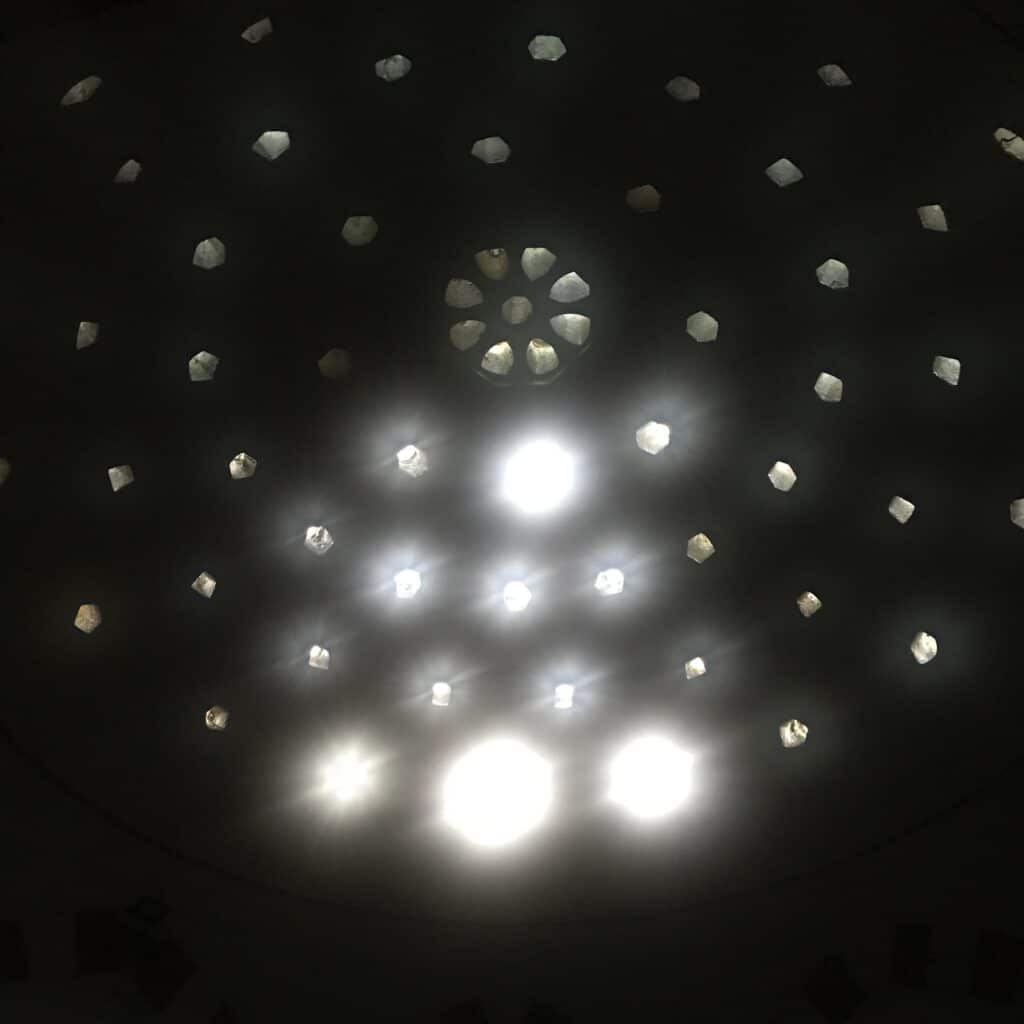🇺🇸 EN
🇹🇷 TR
🇺🇸 EN
The Çinili Bathhouse (this word, “çini” refers to handcrafted porcelain or ceramic artifacts in blue, red, and various colors, often decorated with flower paintings, used in the decoration of royal buildings) was built in 1640 at the request of Kösem Sultan. The Çinili Complex, which includes the Çinili Mosque, the library, and the police station, was planned with these three structures. A bath was added to the complex for the bathing of the masters working in the construction of the Çinili Mosque. All of the tiles (çini) that gave the bath its name were stolen. The structural integrity of the bath has survived until today in Üsküdar.
Traditionally, the Çinili Bathhouse is heated by burning a large cauldron under the section located in the middle of the two domes, closer to the women’s side. Compared to many baths built in its period, it is quite spacious since it was built on a large area.
Glass lanterns covering the holes called elephant eyes opened on the dome to receive light in Ottoman baths allow the light to enter, and when it is very hot inside, these chambers in the domes are removed to allow the bath to breathe.
The men’s section is open every weekday from 07:00 to 22:00.
The women’s section is open every weekday from 08:00 to 19:30.
Inside, there are tellaks and natirs that provide scrubbing and massage services.
Only cash payments are accepted.
Nearby Places To
While visiting the Üsküdar area, there are several notable places worth exploring:
• Mihrimah Sultan Mosque: A stunning example of Ottoman architecture, located near the Üsküdar ferry terminal.
• Fethi Paşa Grove: A beautiful park offering a great view of the Bosphorus and ideal for a leisurely walk.
• Kuzguncuk: A charming neighborhood with colorful houses, cafes, and a bohemian atmosphere.
🇹🇷 TR
Çinisiz Çinili Hamam
Çinili Hamam (Bu kelime “çini”, genellikle mavi, kırmızı ve çeşitli renklerde, çiçek resimleriyle süslenmiş, kraliyet binalarının dekorasyonunda kullanılan el yapımı porselen veya seramik eserlerdir) 1640 yılında Kösem Sultan’ın isteği üzerine inşa edilmiştir. Çinili Cami, kütüphane ve karakolu içeren Çinili Külliyesi, bu üç yapı ile planlanmıştır. Çinili Cami’nin inşasında çalışan ustaların yıkanması için külliyeye bir hamam eklenmiştir. Hamama adını veren tüm çiniler (çini) çalınmıştır. Hamamın yapısal bütünlüğü ise Üsküdar’da günümüze kadar korunmuştur. Geleneksel olarak, Çinili Hamam, iki kubbenin ortasında, kadınlar bölümüne daha yakın olan bölümün altındaki büyük bir kazan yakılarak ısıtılır. Döneminde inşa edilen birçok hamama kıyasla oldukça geniştir çünkü büyük bir alana inşa edilmiştir. Osmanlı hamamlarında ışık almak için kubbede açılan fil gözleri denilen delikleri kaplayan cam fenerler, ışığın içeri girmesini sağlar ve içerisi çok sıcak olduğunda, kubbelerdeki bu odalar çıkarılarak hamamın nefes alması sağlanır. Erkekler bölümü hafta içi her gün 07:00 – 22:00 saatleri arasında açıktır. Kadınlar bölümü hafta içi her gün 08:00 – 19:30 saatleri arasında açıktır. İçeride kese ve masaj yapan tellak ve natırlar bulunmaktadır. Sadece nakit ödemeler kabul edilmektedir. Nearby Places To While visiting the Üsküdar area, there are several notable places worth exploring: • Mihrimah Sultan Mosque: A stunning example of Ottoman architecture, located near the Üsküdar ferry terminal. • Fethi Paşa Grove: A beautiful park offering a great view of the Bosphorus and ideal for a leisurely walk. • Kuzguncuk: A charming neighborhood with colorful houses, cafes, and a bohemian atmosphere.






